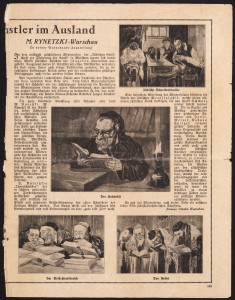A German newspaper article included in the archives of Otto Schneid at the University of Toronto’s Thomas Fisher Rare Book Library. There is no header from the newspaper, so it is unclear which newspaper published the piece, or the date of publication. [NOTE: 1 March 2015 update: The paper is Israelitisches Familienblatt (literally: Israelite Family Paper) and the article was published on 15 May 1930 in the illustrated supplement of the paper, issue number 20. A very special thank you to Assistant Professor Kerry Wallach who is in the Department of German Studies at Gettysburg College, and who was able to determine the source of this article!]
NOTE: Translation from German to English courtesy of Rita Goldhor via her daughter, Ruth Chlebowski.
Young Jewish artists abroad
M. Rynecki – Warsaw
On his Warsaw exhibition
 The recently closed Wintersalon in Warsaw, under the auspices of The Jewish Association for the Promotion of Art, was almost entirely devoted to worthy younger generation Jewish artists. With a total output of about two hundred works, thirty-seven artists were represented. Among those were a few debutants showing promise, and, under favorable circumstances, they can be expected to produce much good work in the future.
The recently closed Wintersalon in Warsaw, under the auspices of The Jewish Association for the Promotion of Art, was almost entirely devoted to worthy younger generation Jewish artists. With a total output of about two hundred works, thirty-seven artists were represented. Among those were a few debutants showing promise, and, under favorable circumstances, they can be expected to produce much good work in the future.
There cannot, of course, be any talk of a particular school or tradition among the society’s presentations, because of the great variety of artistic interpretations in these creative endeavors. They do, however, contribute a good sense of a communal vision, undoubtedly due to the efforts of the Association, who focused on only those works that met the very high standards expected of the young artists.
It was, however, the works of M. Rynecki which cornered the most attention from visitors. M. Rynecki is an artist who devotes himself almost entirely to Jewish themes. Both paintings and drawings represent well-observed Jewish types and genres, such as the Jewish street scene, family, work, Beth Hamidrash, etc. He is able to give us a naturalistic representation, in an original manner. He shows much understanding of local Jewish activities, and thus gives us a true picture, of ghetto life, which is of great interest.
Rolnisski’s “Torah Scribe,” in beautiful green and roseate color harmony, is masterfully executed to evoke the tension and elevated spiritual sensitivity of the old scribe, laboring over the sacred text. The audience experiences strong emotions and is perhaps awakened to memories of “the good old times.”
A special section of the Wintersalon is built up around works in metal and(?) plastics of Jewish objects of worship. This ancient/new artform is being revived in the works of Mark Schwartz, and they attracted a great deal of interest. The expert workmanship of the artists are evident in creations of copper and brass, and incorporates works by Hanft, Merzer, Kahane, Spiegel, etc. Since this revived artform attracted so much attention, it can be expected that some of the Jewish artists will investigate it further. Thus they will be contributing to a revival and knowledge of Jewish traditional life, art, and religious practices, important factors in renewing Jewish life once more.
Thus this year’s Wintersalon gave an excellent presentation of what Jewish artists have been able to create.
-Jesaias Gluski, Warsaw
Painting Titles:
Jewish tailors family (Jüdische schneiderfamilie)
The Kabbalist (der kabbalist)
In Beth-Hamidrasch (im beth-hamidrasch)
The prayer (das gebet)
Original German Article
Junge judische künstler im ausland
Rynecki – Warsaw
Zu seiner Warschauer Ausstellung
In dem unlängst geschlossenen wintersalon der “Jüdischen gesellschaft zur förderung der kunst” in Warsaw waren fast durchwegs werte Jüdischer kunstler der jungeren generation ausgestellt. Insgesamt waren 37 künstler mit etwa 200 Werken vertreten. Es sind unter ihnen auch einige Debütanten gewesen, die zu berechtigten hossnungen anlass geben und bei entsprechenden gunstigen bedingungen noch rieles werden leisten tönnen.
Von irgendeiner einheitlichen Schule oder tradition der Geschaffenen kann natürlich keine Rede kein. troß dieser Mannigfaltigkeit jawohl der Schöpfer wie der Schöpfung hinterlieb die Austellung des wintersalons einen sehr guten gesamteindruck was zweifellos den groben bemuhungen der leitung zu verdanken ist, die, nur wirklich vollwertige, auf hohem niveau stehende arbeiten junger künstler fur die austeilung verwertete.
Die ganz besondere beachtung aller besucher aber fand M Rynecki. M. Rynecki ist ein kunstler, dessen schöpfung fast ausschließlich judischen motiven gilt. Beine Gemalde und Zeichnungen enthalten eine Fiille gut beobachteter jüdischer tipen und Genre-Bilder, die der judischen straße, familie, werkstatte, beth-hamidrasch usw. entnommen find Rynecki versteht es, eine naturgetreue wiedergabe der Gestalten mit einter originalität der auffassung zu verbinbden. Seine arbeiten sind besonders als abspiegelung des judischen volkslebens im Ghetto von großen Interesse.
Rolnißkis “Thoraschreiber” der in schöner grun rosii gen Farbenharmonie meisterhaft gehalten ist, gibt trefflich die bietat und gespannte geistesstimmung desalten schreibers der heiligen schrift wieder. Das ganze wirkt auf den zuschauer sehr stimmungsvoll und ruft Erinnerungen an eine “gute alte zeit” wach.
Eine besondere abteilung des wintersalons bildeten die werke der jüdischen metallplastik welche dieser altneuen judischen kunst huldigen, die von mark schwarz wieder belebt worden ist. Die in kupfer und messing gemeißelten oder geschnißten arbeiten von hanft, merzer, kahane, spiegel erregten großes interesse ob ihrer originalitat und meisterhaften ausfuhrung. Dieses kunst gebiet verdient die großte. Aufmerksamkeit und wird wohl noch manchen judischen künstler veranlassen, seine krafte in bieser. Richtung zu erproben. Insbesondere sind arbeiten die motive aus der altjüdischen künstlerischen. Tradition sowohl der religios shnagogalen wie der volkstumlichen, enthalten, bemerkenswert, da somit die künstler zu einem wichtigen faktor unseres geistigen wiederaufleben werden so gab der wintersalon auch dieses iahr ein anschauliches bild jüdisch-kunstlerischen schaffens.
-Jesaias Gluski, Warsaw